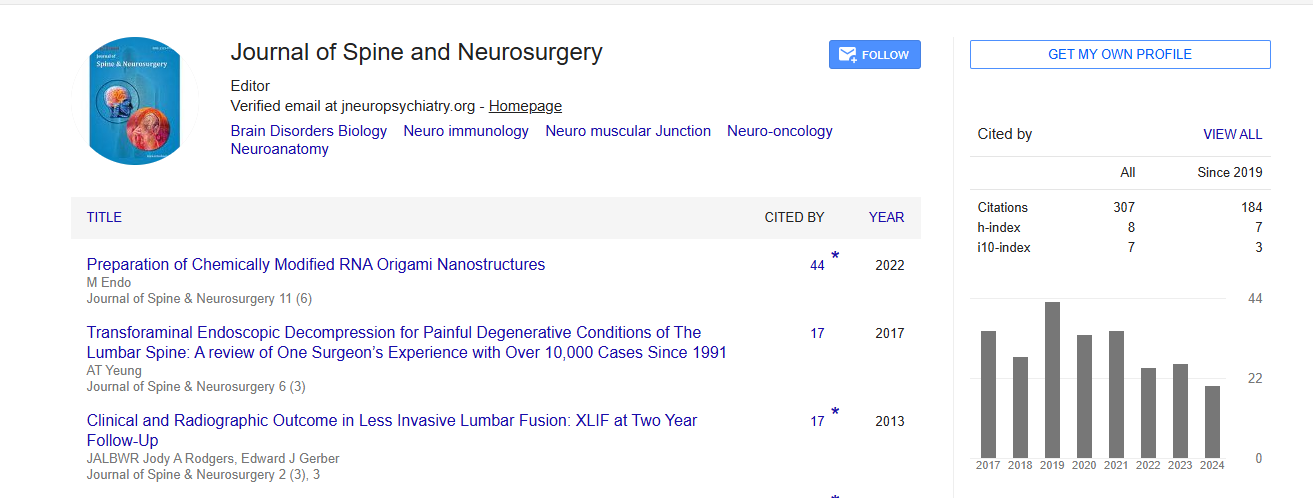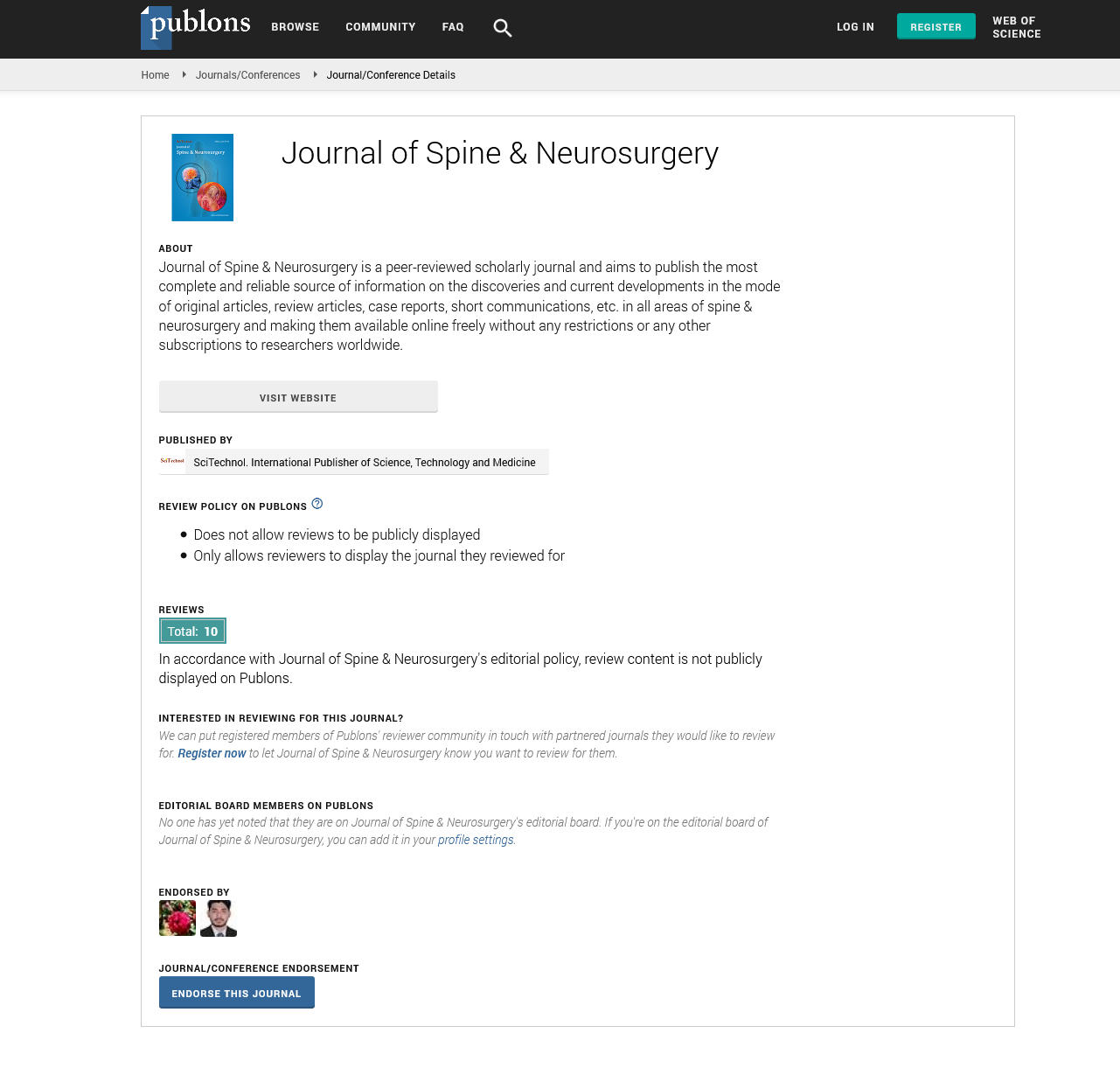Commentary, J Spine Neurosurg Vol: 13 Issue: 4
Innovations in Neuroimaging for Spinal Disorder Diagnosis and Management
David Zaragita*
1Department of Neurosurgery, The University of South Alabama, New York, USA
*Corresponding Author: David Zaragita,
Department of Neurosurgery, The
University of South Alabama, New York, USA, USA
E-mail: david.zaragita@gmail.com
Received date: 27 July, 2024 Manuscript No. JSNS-24-152424;
Editor assigned date: 30 July, 2024, PreQC No. JSNS-24-152424 (PQ);
Reviewed date: 12 August, 2024, QC No. JSNS-24-152424;
Revised date: 19 August, 2024, Manuscript No. JSNS-24-152424 (R);
Published date: 29 August, 2024, DOI: 10.4172/2325-9701.1000213.
Citation: Zaragita D (2024) Innovations in Neuroimaging for Spinal Disorder Diagnosis and Management. J Spine Neurosurg 13:2.
Description
Neuroimaging has revolutionized the field of neurosurgery and spinal medicine, providing invaluable insights into the anatomy and pathology of the spine and nervous system. Techniques such as Magnetic Resonance Imaging (MRI), Computed Tomography and functional imaging have become essential tools for diagnosis, treatment planning and outcome assessment in spinal disorders.
Magnetic Resonance Imaging is often considered the gold standard for visualizing spinal anatomy due to its high-resolution images and ability to differentiate between various tissue types. It is particularly effective in assessing intervertebral disc herniations, spinal stenosis and tumors. Recent advancements in MRI technology, including highfield magnets and diffusion tensor imaging, allow for better visualization of soft tissues and nerve tracts. MRI is major magnets for diagnosing herniated discs, revealing not just the presence but also the degree of nerve root compression. It assists in identifying the type, location and extent of tumors, facilitating surgical planning. Additionally, MRI can help monitor conditions like spondylosis and disc degeneration over time, providing insight into disease progression.
Computed Tomography imaging offers rapid and detailed images of bony structures, making it particularly useful in trauma cases and surgical planning. While MRI excels in soft tissue visualization provides excellent images of the spine’s osseous structures. In acute settings scans are invaluable for quickly assessing fractures and dislocations. CT myelography can be used to visualize spinal anatomy before surgery, especially in cases where MRI is contraindicated.
Functional neuroimaging techniques, such as Positron Emission Tomography and functional MRI, are emerging as important tools for understanding the neurological impact of spinal disorders. Functional imaging can help identify the neural correlates of chronic pain in conditions like failed back surgery syndrome, guiding treatment approaches. Research has shown changes in brain activity related to spinal disorders, indicating neuroplastic changes that may affect recovery.
Recent advancements in artificial intelligence and machine learning are beginning to enhance the capabilities of neuroimaging in spinal disorders. AI algorithms can analyze imaging data to predict patient outcomes, identify patterns that may not be visible to the human eye, and assist in diagnostic processes. AI can help stratify patients based on imaging findings, allowing for tailored treatment strategies and machine learning algorithms can generate automated reports, improving workflow efficiency in radiology departments.
While neuroimaging has advanced significantly, challenges remain. Issues such as the high cost of advanced imaging techniques, the need for specialized training and the potential for over-reliance on imaging data in clinical decision-making persist. Future research should focus on integrating neuroimaging with clinical outcomes, improving standardization of imaging protocols and exploring new imaging modalities that can provide more comprehensive data.
Conclusion
Neuroimaging continues to be a keystone in the management of spinal disorders, enhancing diagnostic accuracy and influencing treatment strategies. As technology evolves, the integration of advanced imaging techniques and AI will likely further refine our understanding of spinal pathologies, ultimately improving patient care and outcomes. Continued collaboration between radiologists, neurosurgeons and other healthcare providers is essential to harness the full potential of neuroimaging in spinal medicine. Moreover, ongoing research into the quantification and visualization of spinal conditions through neuroimaging will facilitate the development of personalized treatment plans. By taking advantage of data analytics and machine learning, we can better identify patterns and predict outcomes, allowing for more targeted interventions. As we continue to explore the aspects of the spine through advanced imaging techniques, supporting interdisciplinary teamwork and maintaining open lines of communication among specialists will be essential. This collaborative approach not only enhances our diagnostic capabilities but also ensures that patients receive comprehensive, multidisciplinary care tailored to their unique needs.
 Spanish
Spanish  Chinese
Chinese  Russian
Russian  German
German  French
French  Japanese
Japanese  Portuguese
Portuguese  Hindi
Hindi 
